The Big Read: Rising prices, building delays — young couples face perfect storm in quest for home sweet home
The delays couldn’t have come at a worse time for young couples eager to set up their very first marital home, newly-weds say.
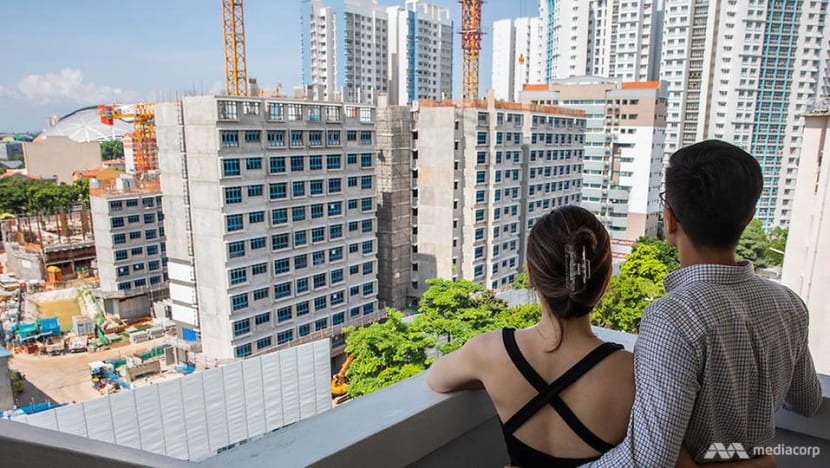
In pre-pandemic days, prospective homeowners were waiting for about three to four years following a new launch for a flat under the BTO scheme. Now, they will have to add between six and nine months, or even a year in some cases, to the waiting game. (Photo: TODAY/Ili Nadhirah Mansor)
SINGAPORE: Fang (not her real name), 30, used to be able to put up with living at her in-laws’ place, where she and her husband have been staying since 2019 while waiting for her Build-To-Order (BTO) flat in Punggol which was supposed to be ready by this year. Not anymore.
Having to work from home like many others after COVID-19 struck last year, the manager saw her productivity plummet as she had to talk to her clients and conduct video-conferencing calls from the kitchen of the four-room Housing and Development Board (HDB) flat.
And no matter how hard Ms Fang tried to be extra mindful of the needs of her in-laws, who were themselves working via teleconferencing, she noticed tension between her and the elders building up over the months.
Soon, she found herself shuttling between living at her in-laws’ place in Punggol and her parents’ Farrer Park three-room flat to preserve everyone’s sanity — only to have the sight of the seven to eight boxes cluttering her room serve as a reminder of an unfulfilled dream.
They contained items such as kitchenware and tupperware which she had bought pre-pandemic, thinking that her marital flat could be ready earlier than expected. After all, it is not uncommon to hear of homeowners collecting their key up to a year ahead of schedule.
But it was not to be. She is now expecting her flat to be delayed by a year.
Ms Fang’s split-living arrangement inevitably means that she and her 30-year-old husband will have to spend some nights alone, as he prefers to stay at his parents’ home since it is nearer to his workplace.
“I believe our plans to have children would have to be pushed back,” she lamented.
READ: Commentary: If your BTO flat is delayed, staying with parents or in-laws isn’t a bad idea
The newly-weds are not the only ones in Singapore whose plans have been derailed due to a pandemic-induced delay in getting keys to their dream flats.
More than 40,000 households waiting for their BTO flats are now in the same boat, as the construction sector — already struggling to clear a huge backlog after restrictions to ease the virus’ spread eased — continues to grapple with global supply chain disruptions and manpower shortages.
In pre-pandemic days, prospective homeowners were waiting for about three to four years following a new launch for a flat under the BTO scheme — often regarded as the Government’s primary lever to provide affordable homes to those wishing to start a family.
Now, they will have to add between six and nine months, or even a year in some cases, to the waiting game.
The delays couldn’t have come at a worse time for young couples eager to set up their very first marital home.
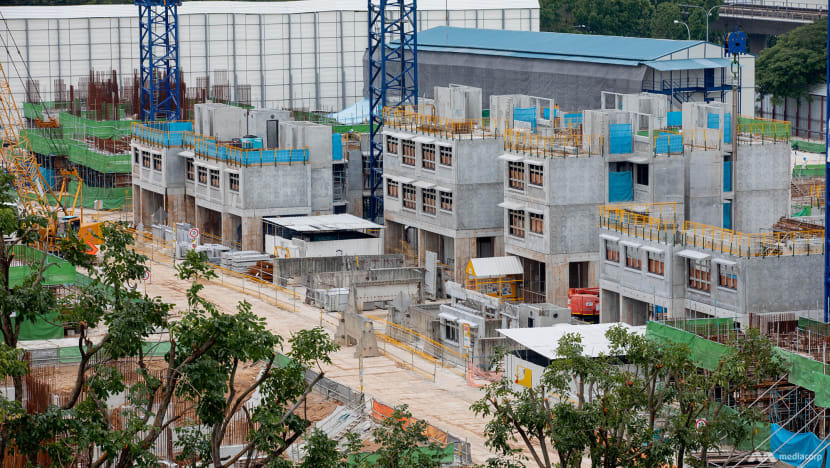
The buoyant housing market — which seems to care little for the economic havoc caused by COVID-19 — means that other options, such as buying a resale HDB flat, are slipping from their reach.
HDB resale prices had shot up by 8.1 per cent following four consecutive quarters of increases in the past year, and are currently just 4.8 per cent below the last peak in 2013.
In the private market, prices are at a historic high, making apartments or houses in the sector even more inaccessible to many young couples. Prices jumped 3.3 per cent in the first three months of the year, marking the steepest quarterly increase since the second quarter of 2018.
READ: Commentary: Why Singapore's private residential market will remain attractive in the long term
Even the rental market cannot provide much reprieve, as couples find it increasingly expensive to rent flats.
Based on March’s flash data from real estate portal SRX, condo rents are 2.4 per cent higher than in March last year after climbing three months in a row, while HDB rents are 3.4 per cent higher over the same period, having risen for nine consecutive months.
This perfect storm in the housing market, said analysts, is driven by BTO construction delays, the low interest rate environment which has persisted amid the global economic slowdown; and rising demand from foreign investors, backed by the prospects of further price growth and an improving leasing environment.
As these factors are likely to persist for some time, some analysts are predicting that private residential prices will chalk up 4 to 10 per cent gains in the full year, while HDB resale prices are expected to rise by 5 to 9 per cent.
The situation is not unique to Singapore, with countries such as Australia and the United States also experiencing a housing boom, due to a combination of various factors including those related to the pandemic.
(Are cooling measures on the cards after four quarters of price increases in the residential property market? CEO Propnex Ismail Gafoor and NUS Institute of Real Estate Studies Dr Lee Nai Jia advise what to look out for on CNA's Heart of the Matter podcast:)
HITS CLOSE TO HOME
With the “perfect storm” unlikely to blow over anytime soon, some couples who are planning to get married or starting a family have had to go back to the drawing board.
Due to the delay in BTO delivery dates, some said that they had to delay their wedding plans to around the time when their flats would be ready.
Others have decided to delay parenthood, while some like 30-year-old Abdul Aliff have no choice but to welcome a new member of the family before their “nest” is ready.
The freelance technician, whose wife is expecting their first child, is currently renting a one-bedroom apartment in Punggol for S$600 from his elder brother.
READ: Commentary: When Singapore homes become workspaces – huge changes in the house and beyond
He had initially wanted to have a child only after he and his 28-year-old wife moved into their BTO flat in Sengkang — which might still have been possible if not for the construction delays — but “God has better plans”, he quipped.
Still, the one-room flat is too small for a family of three. They could only buy travel cots or foldable cribs as there isn’t enough space for a proper crib. It would also be easier to move when they get the keys to their own place by the second quarter of 2023, he said.
“Everything we’re getting for the baby is either the mini version or something that we can easily pack in a box and shift,” he said.
For those who have opted to continue renting while they wait for their delayed BTO flats, it means having to fork out more than what they had originally budgeted.
READ: Commentary: Succeed in your career, settle down, buy a BTO. Is this Singaporean dream outdated?
Take the case of a 28-year-old civil servant who declined to be named. She and her husband got married in 2019 and decided to rent at a prime location, thinking that it would only take two years at most, with the expectation that their BTO flat would be ready by June this year.
But when it was confirmed that their BTO development at Punggol’s Waterway Sunrise II — which required a change of contractors — would be delayed by a year, they had to break the lease for their Holland Village unit and move into a cheaper rental flat in Punggol to save money.
“If we had continued to rent at the original location and paid a higher rent, it would be much more difficult for us to save up for the HDB in the future. In a sense, we are burning more of our savings,” she said.
Mr Justin Ong, 28, a sales and leasing manager, and Ms Jen Lee, 29, a customer success manager, are also planning to rent from the middle of next year, after realising that their BTO flat in Kallang is going to be delayed for nine months, till May 2023.
Since they would not be able to immediately move into their new home after getting married in December next year, the couple felt they could take the time to learn to live with one another before tying the knot, then continuing with this living arrangement after marriage.

But given the current market conditions and the S$2,000 budget for monthly rent, they foresee having to recalibrate their expectations — from a one-bedroom apartment in a mature estate to one at a non-central part of Singapore.
“S$2,000 is not a realistic budget for an accessible area. Those units are going at around S$2,800, or even more than that. Prices now are quite expensive for anything that is decently located, with decent furniture and decent interiors,” said Ms Lee.
Like the 28-year-old civil servant, Mr Ong and Ms Lee are wary of renting for too long as well, pointing out that a year of renting with their S$2,000 monthly budget could have gone towards covering half the renovation cost for their eventual home.
“The money is going to the landlord, not a downpayment to our own property, our own assets,” said Mr Ong.
Earlier in April, in giving an update that about 43,000 households were affected by construction delays as of end February, National Development Minister Desmond Lee told Parliament that those who are unable to find alternative housing arrangements with family members, relatives or on the open market in the interim may contact HDB for assistance.
READ: Want more babies? Help couples build stronger marriages first, a commentary
Around 240 households were helped with Interim Rental Housing flats, which are public rental flats offered to those with financial difficulties.
For those who can afford to pay more or want a bigger rental flat, they can apply for one under the Parenthood Provisional Housing Scheme (PPHS), which are primarily vacated flats from HDB’s past Selective En Bloc Redevelopment Scheme exercises.
Rental rates for PPHS flats are based on their locations and type. They range from S$400 for a two-room flat in Canberra, Marsiling or Woodlands to $$1,500 for a four-room flat in Tiong Bahru, but they don’t come furnished.
Mr Lee said that HDB received 2,350 applications to rent a flat under this scheme last year.
Of these, 66 per cent came from married couples; 31 per cent from couples under the fiancé/fiancée scheme; and the remaining 3 per cent were from applicants who were divorced or widowed with children.
READ: Commentary: An elderly public housing project is a game-changer but mindsets still need shifting
RESALE MARKET SITUATION
While the HDB resale market offers a faster way for many young couples to get a flat, some lamented that they are not able to find a unit with the “right attributes” to set up a family, as the prices of such flats have ballooned beyond their budgets.
Graphic artist Mark Yong, 28, for example, had set aside a S$470,000 budget for a five-room HDB flat in Sengkang that is within walking distance from an MRT station.
While his friend managed to snag one of these units on the mid-floor for S$460,000 in the middle of last year, Mr Yong, who proposed to his girlfriend last month, is now looking at resale units costing at least S$500,000, even though some of them are on low floors.
He has decided to wait for the market to cool down in the next one to two years before buying a flat — which means that he and his girlfriend would not be able to get their own house in time for their wedding in August.
In the meantime, they will live with other tenants at his parents’ five-room flat, which is being rented out.
READ: The Lease Buyback scheme can give singles more housing options, a commentary
READ: HDB resale prices climb for 4th consecutive quarter in Q1
He does not rule out the possibility of falling back on BTOs, but a lead time of five to six years would disrupt his plans to have three children by the time he turns 35.
“It would be quite terrible to have kids and then move,” he said.
Communications consultant Ho Xiu Xian, 28, and her fiancé, filmmaker Jun Chong, 30, felt that a lot of their housing decisions had been “compromised and affected” due to the rising costs of flats.
They are hoping to live near either of their parents in Tiong Bahru and Bishan, which are prime areas.
“Should we wish to stay in these locations, we would have to be prepared to compromise and settle for a smaller flat. However, this will not be an ideal solution, especially if we plan to have children,” Ms Ho said.
A 27-year-old engineer, who only wanted to be known as Maegan, said the uncertainty surrounding whether her BTO flat, which was slated for completion in 2024, would be delayed has made it hard to plan having a family and budget for the next few years.
Most of her friends are not considering a BTO unit at all and going straight for resale flats, she said.
However, the cash outlay can be too high for young couples in the current resale market, given that cash over valuation (COV) has begun to rise after staying suppressed for years.
Property experts said recent COV figures typically range between S$10,000 and S$50,000. However, it is not unheard of for someone to pay between S$100,000 and S$200,000 for choice flats.
Fresh graduate Vishaljit Singh Sandhu, 27, who is currently looking for a job, suggested waiving the COV’s cash requirement for first-time buyers, so they can service the amount by mortgage instead.
He was hit with a S$40,000 COV for his recent S$425,000 four-room flat purchase with his 25-year-old fiancée, and was only able to pay the amount in cash due to his late father’s insurance claims. The flat is located opposite Admiralty MRT Station at Woodlands Ring Road.
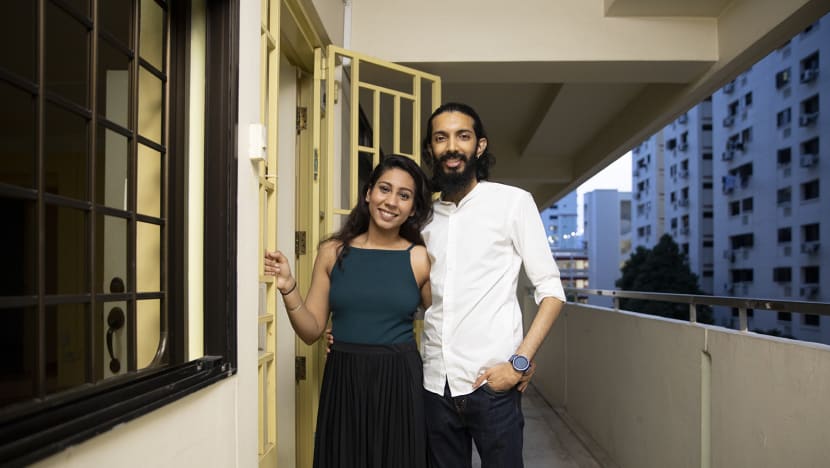
OVER IN THE PRIVATE PROPERTY SEGMENT…
If young couples are finding it increasingly hard to get an affordable public flat which meets all their criteria, would getting a home in the private property market — which has also been hit by building delays and is facing renewed interest from foreign investors — be even more of a pipe dream in the current climate?
Mr Alan Cheong, executive director of the research and consultancy team at real estate firm Savills Singapore, said it is still possible for an average 30-year-old couple to buy a condo — if they don’t mind staying in a smaller condo unit compared to a HDB flat.
They would most likely also need to have a combined income of at least S$12,000, and have well-heeled parents who could support their condo’s hefty 25-per-cent down payment, which could easily amount to S$300,000 for a S$1.2 million unit, he added.
READ: Analysts expect private home prices to rise further on tight supply and strong demand
Indeed, a couple in their early 30s — a lawyer and an office administrator who both declined to be named — said they would only be able to afford to buy a two-bedroom condominium in the city fringe with their parents’ financial support.
The couple started looking for a condo that costs between S$1.2 million and $1.5 million last month, since their parents were willing to help pay part of the “painful and very big” down payment first while they slowly repay them in the future. They are comfortable with the mortgage due to their combined income of more than S$15,000.
A 29-year-old founder of a local start-up in the agricultural sector, however, said that she has yet to find a suitable small private home after a three-year search.
The woman, who wanted to be known only as Ms Foo, feels that her budget of S$1.6 million to S$1.7 million is midrange. She had expected to snag a freehold two-bedder that costs S$1,700 per square foot (psf) either in District 10, 11 or 15 with her budget, but such units are out of her reach.
“I can find a random two-bedder, but to find a freehold place that is decently comfortable is very challenging,” she said.
Ms Hoong Huifang, 31, who is currently looking to buy a private apartment with her husband, wants a house that is close to where their parents live, in the Core Central Region.
However, most of the new condo launches around the area are in the S$2,000 psf range, and older condos at least the size of a four-room BTO are priced at around S$1.5 million.
“Of course, another option would be to live further away from our parents as houses would be more affordable in those areas, but proximity is a priority for us,” she said.
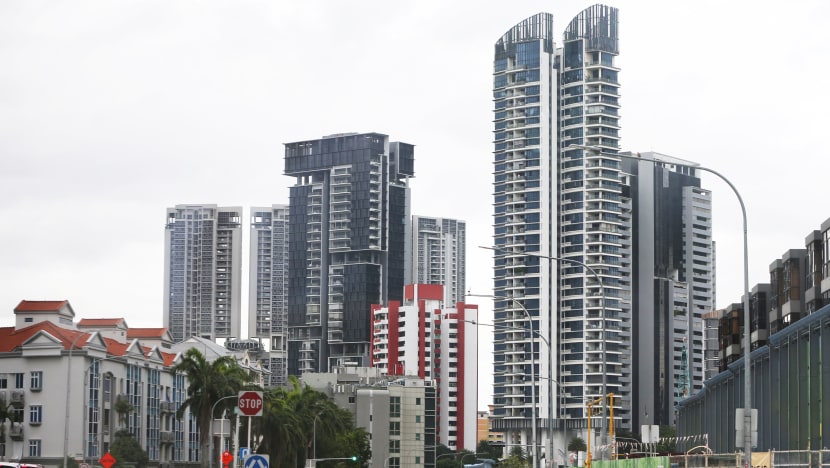
A Singaporean-foreigner couple interviewed is also caught in a bind.
After renting a S$3,200-a-month flat here for four years, a 37-year-old manager, who wanted to be known only as Anna, said she and her American husband started contemplating buying a house last November. Her husband, also 37, is an IT consultant on an employment pass.
But the couple with a combined income of more than S$14,000 recently decided to give up on the idea of getting a HDB resale flat or a condo.
Although they could technically afford a S$750,000 HDB flat in Rochor, which they were eyeing, they could not get enough of its upfront cost covered, given that banks are compelled to assess their ability to service the mortgage solely based on the salary of the Singaporean, Anna’s in this case.
“Under one salary, the quantum that we can borrow from the bank is really low. It’s so pathetic that we almost cannot afford a resale HDB unless we go to Chua Chu Kang and buy a three- or four-room flat,” the mother of a two-year-old said.
They then turned to the private market hoping to get a two-bedroom condo for about S$1.2 million, but they soon realised that the ones in Chua Chu Kang are costing S$1.4 million to S$1.5 million. Even worse, they would be subjected to a 25-per-cent down payment.
READ: Commentary: Concerned about what fall in private home sales mean? Market fundamentals paint a different story
The requirement kicked in when the last round of market cooling measures were implemented in July 2018, which revised the sum that buyers could borrow from a bank to finance their home loan from 80 per cent of the purchase price or property value to 75 per cent.
Of the remaining 25 per cent, 5 per cent must be paid in cash, while the remaining 20 per cent can be paid using a combination of cash or savings from the buyers’ Central Provident Fund (CPF) Ordinary Account.
That, plus legal fees, stamp duties and renovation costs, would “wipe out” all their savings, Anna said.
ARE YOUNG PEOPLE PRICED OUT OF THE MARKET?
Mr Lee, the National Development Minister, had said in January that the Government is monitoring developments in the property market “very closely” and will adjust policies if necessarily, to maintain a stable and sustainable property market for all Singaporeans.
But as private home prices hit new highs and HDB resale prices continue to rise, some homeowners or potential homebuyers interviewed believe that the time is ripe for some government intervention to help them afford their first flats.
READ: Industry players should not 'stoke exuberant sentiments' in property market: Indranee Rajah
Ms Ho said: “If the costs continue to rise without certain aggressive measures to help first-time home owners, home ownership will gradually skew towards the privileged, and young couples like us will find it extremely strained to continue to pay off the flat.”
In assessing the affordability of home ownership, property experts said that one indicator is the median price to income ratio.
The Business Times did such an analysis last month and found that the gap between prices of new condominiums sold and household income was at its widest in a decade, at 15.4 last year.
This means that a household, without spending on anything else, has to save for at least 15.4 years in order to afford the new condo unit.
The ratio for resale condominiums stood at 11.2, while the ratio for HDB resale flats was 3.9.
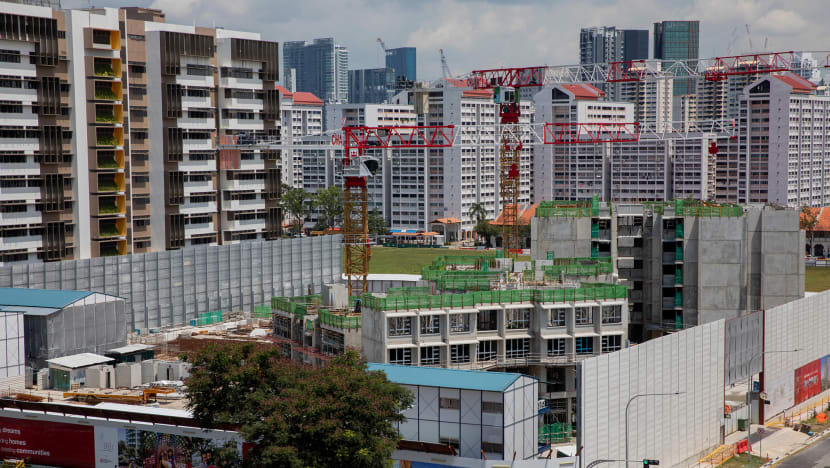
Professor Sing Tien Foo, director at the National University of Singapore’s (NUS) Institute of Real Estate and Urban Studies (IREUS), said BTO flats are relatively affordable if the ratio could be kept at around four to six times before subsidies for couples with a household monthly income of around S$5,000 to S$7,000.
With the rising prices in the HDB resale market, he expects the ratio to stretch to around eight to 10. The ratio could be stretched to as high as around 14 to 15 times for private non-landed houses, if median income has not increased in tandem, he added.
“Many low and median-income young couples are likely priced out of the private markets at these levels, where they need to save 14 to 15 years, without setting aside for other expenses, to purchase the private housing,” Prof Sing said.
Associate Professor of Urban Planning Lee Kwan Ok at NUS said Singapore’s ratio in the public housing space is “actually not very high”, compared to other global cities such as Hong Kong, although its ratios are “definitely getting higher”.
However, the ratio for private homes is one of the highest across the world.
“Because the average income of young people is usually lower, the chance for them to buy private housing would be even smaller,” she said.
The Government should try to keep the ratio in check because if the private housing option is beyond their ability to pay, people with above-average salary may be forced to buy from the HDB resale market, driving up demand and prices, Assoc Prof Lee said.
GOVT INTERVENTION NEEDED?
Even so, Mr Cheong of Savills said he does not think any affirmative action should be taken to help the younger generation buy private properties.
“Ultimately, this will drive up prices even more and create further problems down the road. The best way to get people up the income ladder is to make them relevant to the economy for a longer period of time, like into their 60s.”
He added: “If one enacts policies to assist the young to move up the housing ladder, there will be the attendant asset price inflation problem.
“Also, there is the possibility that any help given to the younger cohorts in the economy may inadvertently end up disadvantaging the middle age to older working population because from the start, the latter group already cannot keep up with the pace and productivity levels of the former.”
The experts said blunt cooling measures would not help, either.
Prof Sing said that while they could dampen the demand from investors or speculators and help stabilise prices, especially in the private residential segment, the correction may cause developers or existing owners to hold back their launches and sales, causing the supply to decline.
This would, in turn, make it hard for young couples to upgrade, he noted.
“Given the current ultra-low interest rate environment, high transaction costs may still not fully eliminate hot money seeking for safe haven in Singapore, if foreign investments continue to pour into local private housing markets,” he added.
READ: Commentary: Keeping public housing in prime locations like Greater Southern Waterfront affordable and fair
Agreeing, Mr Nicholas Mak, ERA’s head of research and consultancy, said further cooling measures would “just be delaying the inevitable”.
The Government has been keeping prices artificially low, he said, citing how over the past decade, incomes had risen and gross domestic product grew faster than the private residential price index.
“The Government could be throwing more rocks on the lid to cool the market temporarily, but underneath, the heat is still there. The pot is going to boil over,” he added.
As to whether it would be a good idea to waive the COV’s cash requirement for first-time buyers, the experts said the move sounds easy to implement, but comes with major ramifications if the market crashes.
Dr Lee Nai Jia, deputy director of IREUS, said such a waiver requires the underwriting institution, such as HDB or banks, to take up more risk, as the collateral worth of the estates that got their COV cash requirement waived would be lower if the market changes.
“You are essentially allowing borrowing above 100 per cent. For the resale market, is that viable?” he said. “If everything tanks, HDB can be bankrupt, throwing a much bigger problem down the road.”
To increase supply in the resale market to counter the effects of BTO construction delays, Dr Lee said HDB can consider reducing the five-year Minimum Occupation Period for new flats to three or four years for the time being.
He added that this would not only increase the pool of HDB flats in the market that people can buy, it would create more competition, resulting in a lowering of COV rates as prices fall.
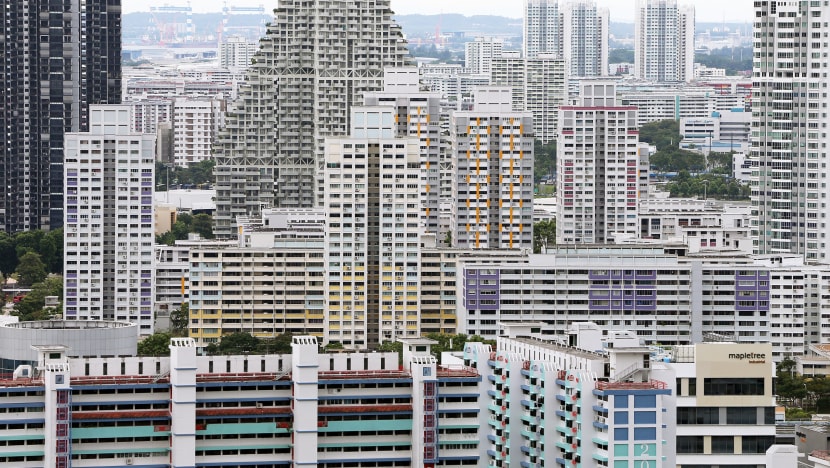
Assoc Prof Lee Kwan Ok said one possible government action may be to increase property tax for existing homeowners, especially those who own multiple luxurious housing units.
“One simple reason behind the supply-demand gap is because some people own multiple homes,” she said. “The government action should be towards giving more pressure to these people and making them sell their housing in the market, and in turn, increasing supply for young people.”
Dr Sky Seah Kiat Ying, a senior lecturer at NUS’ Department of Real Estate, said it would be useful to see how rising housing prices impacts the distributions of income, housing quality and prices, in order for the Government to understand which segment of the population is underserved.
READ: Commentary: Budget 2021 and how Singapore’s tax system is changing for the better
“It is not just looking at average prices but also looking at who is doing really well versus who is not doing well at the different income percentiles,” she said.
To address immediate needs, Mr Henry Kwek, Member of Parliament for Kebun Baru, had in February proposed building a certain type of HDB flats that can be used as "stock holding" so that young couples with children can live in them while waiting for their BTO flats to be completed.
In the same vein, NUS’ Associate Professor Fu Yuming suggested that the Government’s approach does not always have to be building new homes for sale only.
He pointed out that built-to-rent housing that provides tenure security and attractive shared amenities is getting popular among young people in many countries.
“It expands the diversity of housing opportunities, especially for people facing credit constraints for homeownership. The built-to-rent housing also provides attractive long-term investment opportunities sought after by institutional investors,” he said.










